Sri Lankan Antiquity |
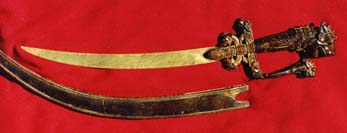
The national sword of Ceylon. Typically a short curved single-edged watered blade, double-edged at the point. The hilt comprises a knuckle-guard and down-turned quillons, each terminating in a dragon's head with large in-set eyes. The dragon's head is usually decorated throughout with gold or silver panels and the pommel with tongue is formed from a piece of wood or red coral. The dragon's mane trails down the grip and is decorated with silver and gilt repousse floral designs. The entire hilt is often made of silver or gold and even inlaid with jewels. The blade close to the hilt is decorated with floral or thatched designs. The scabbard is made from wood and is covered with embossed and chased silver worked with flowers with leafy borders and richly ornamental.
The swords were intended to serve as badges of rank. Rev. James Cordiner in 1807 wrote that everyone in office wears a sword with a silver hilt and scabbard. These swords were made in the Royal workshops known as the "Rankadu Pattala" or "golden sword workshop" and the quality of the piece always depended on the rank of the wearer.
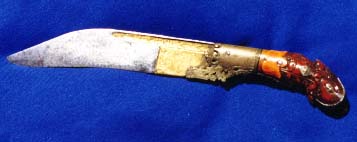
A Ceylonese knife. Usually a broad single-edged steel blade with double fullers along the back edge to the forte, partly covered on each side with partly pierced silver-inlaid brass panels. The blade is often cast and chased with dense foliate motifs. The grip is usually carved ivory or wood mounted in silver and has a silver pommel-cap, with scrolling foliage worked into the cap.
These elaborately decorated knives were usually the product of the "Pattal-hatara" or "four workshops" with the blades being supplied by the local smiths. This was a mainly hereditary corporation of the best craftsman who worked exclusively for the King of Kandy. Originally there was only one "pattala", but this was subsequently divided into sections, which included a "Rankadu pattala" or "golden sword workshop". As well as being worn by courtiers, these knives were given by the king to nobles and high-ranking officials.
1a.
 1b.
1b.
 2a.
2a.
 2b.
2b.
 3a.
3a.
 3b.
3b.

4a.
 4b.
4b.
 5a.
5a.
 5b.
5b.

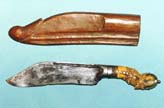
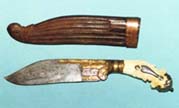
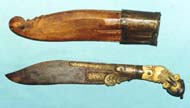
17th Century to 19th Century. Blades inlaid at the forte with brass panels engraved with scrolls. Ivory
hilt carved with scrolls and with silver mounts embossed with foliage. Original fluted wood scabbard.
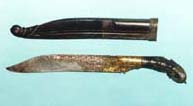
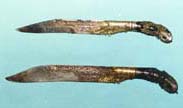
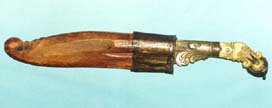
Sales Information